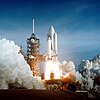STS-36
| Mission emblem | |||
|---|---|---|---|

|
|||
| Mission dates | |||
| Mission: | STS-36 | ||
| COSPAR-ID : | 1990-019A | ||
| Crew: | 5 | ||
| Begin: | February 28, 1990, 07:50:22 UTC | ||
| Starting place: | Kennedy Space Center , LC-39A | ||
| Landing: | March 4, 1990, 18:08:44 UTC | ||
| Landing place: | Edwards Air Force Base , Runway 23 | ||
| Flight duration: | 4d 10h 18m 22s | ||
| Earth orbits: | 72 | ||
| Track height: | 244 km | ||
| Orbit inclination : | 62.0 ° | ||
| Covered track: | 3.0 million km | ||
| Team photo | |||
 v. l. No. Pierre Thuot, John Casper, John Creighton, Richard Mullane, David Hilmers |
|||
| ◄ Before / After ► | |||
|
|||
STS-36 ( English S pace T ransportation S ystem) is the designation for a mission flight of the space shuttle Atlantis (OV-104) of NASA for the US Department of Defense . The launch took place on February 28, 1990. It was the 34th space shuttle mission and the sixth flight of the space shuttle Atlantis.
team
- John Creighton (2nd spaceflight), commander
- John Casper (1st spaceflight), pilot
- Richard Mullane (3rd spaceflight), mission specialist
- David Hilmers (3rd spaceflight), mission specialist
- Pierre Thuot (1st space flight), mission specialist
Mission overview
This was the sixth space shuttle flight commissioned by the US Department of Defense. The space shuttle Atlantis brought a reconnaissance satellite of the US Air Force in a low orbit, from where should monitor most of the earth's surface from this. The spy satellite is camouflaged as USA-53 (1990-019B), details were not disclosed.
begin
The start was originally planned for February 22nd, it was postponed to February 25th due to two crew members suffering from the flu and then due to bad weather conditions. The outer tank was already filled for this start attempt. However, there was another delay due to a security computer malfunction and adverse weather conditions.
The start finally took place on February 28th. The space shuttle was supposed to leave Earth at midnight, but the launch window was temporarily extended to 4 a.m. EST.
damage
After landing, the clearing team counted 62 cracks in the tiles , but according to the engineers only one tile had to be replaced. The brakes and tires had withstood, but drops of hydraulic fluid were found in the right main landing wheel well and on two of the main gears.
See also
Web links
- NASA Mission overview (English)
- Video summary (without sound) (English)
- STS-36 in the Encyclopedia Astronautica (English)
- Michael Cassutt: Secret Space Shuttles (English)
